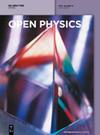Thermal proficiency of magnetized and radiative cross-ternary hybrid nanofluid flow induced by a vertical cylinder
IF 1.8
4区 物理与天体物理
Q2 PHYSICS, MULTIDISCIPLINARY
引用次数: 0
Abstract
The ternary hybrid nanofluid leads to a significant enhancement in thermal performance applications like heat transfer in automotive engines, solar thermal energy storage, aerospace, and electronic cooling. The present study investigates the thermal characteristics of a ternary hybrid magnetized and radiated cross nanofluid comprising Al垂直圆柱体诱导的磁化和辐射交叉三元混合纳米流体流动的热学性能
三元混合纳米流体可显著提高热性能应用,如汽车发动机传热、太阳能蓄热、航空航天和电子冷却等。本研究探讨了由 Al2O3、TiO2 和 Ag 纳米颗粒组成的三元混合磁化和辐射交叉纳米流体在水中的热特性,该流体在垂直圆柱体周围进行联合对流。此外,还考虑了磁场、圆柱体的吸收表面、非线性热辐射和三元纳米流体的有效热物理特性等创新效应,成功建立了一个新的热传输模型。应用当前假设,通过纳维-斯托克斯方程和热方程,得到了偏微分方程(PDE)形式的控制方程。通过相似变量将偏微分方程系统转换为常微分方程组。Matlab 软件中的内置代码 bvp4c 进一步对无量纲常微分方程进行数值计算。添加多个纳米粒子和磁场效应提高了三元混合交叉纳米流体的传热速率。魏森伯格数降低了速度,辐射参数增加了热量传输,纳米粒子体积摩擦的增加提高了热导率和热量的快速传输。
本文章由计算机程序翻译,如有差异,请以英文原文为准。
求助全文
约1分钟内获得全文
求助全文
来源期刊

Open Physics
PHYSICS, MULTIDISCIPLINARY-
CiteScore
3.20
自引率
5.30%
发文量
82
审稿时长
18 weeks
期刊介绍:
Open Physics is a peer-reviewed, open access, electronic journal devoted to the publication of fundamental research results in all fields of physics. The journal provides the readers with free, instant, and permanent access to all content worldwide; and the authors with extensive promotion of published articles, long-time preservation, language-correction services, no space constraints and immediate publication. Our standard policy requires each paper to be reviewed by at least two Referees and the peer-review process is single-blind.
 求助内容:
求助内容: 应助结果提醒方式:
应助结果提醒方式:


